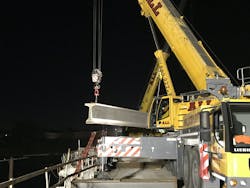Cranes help set beams for Florida bridge widening
It is often said that football is a game of inches. So is using two cranes to set 120,000-lb bridge beams.
“With those final, exacting adjustments, you absolutely must have selected the right machines and the most experienced operators,” said Edwin Suazo, project coordinator for ALL Sunshine Crane Rental of Apopka, Fla., a member of the ALL Family of Companies.
Suazo’s team recently worked a bridge widening for Lane Construction on Florida S.R. 408, a highway serving the East-West corridor of the Orlando metroplex.
Cutting through one of the world’s worst cities for traffic, the roadway sees more than 400,000 vehicles per day. The high traffic volume made daytime work impossible—there was simply no way to take cars down to one lane without bringing the city to a standstill.
As a result, Suazo’s team had to do its work after midnight. On the night of the scheduled pick, the rains came. So again, as in football, sometimes a team has to perform critical lifts at night in the rain.
The team was undaunted. “Fortunately, it was a light rain and didn’t significantly impact us,” said Suazo.
The cranes, chosen for their capacity, were a Liebherr LTM 1350-6.1 (350 USt) and a Grove GMK6400 (450 USt). The Liebherr had 98.8 ft of telescopic boom at 66º, 100% outriggers at 29.2 ft x 27.9 ft, 66,100 lb of counterweight and a 38-ft lift radius. The Grove had 103.2 ft of main boom at 64.8º, 100% outriggers at 28.5 ft x 27.8 ft, 77,100 lb of counterweight and a 40.1-ft lift radius.
ALL Crane provided both operators for the job, each a three-decade veteran with dozens of similar picks on his resume.
After making the initial pick, the rigging foreman had to check and balance the weight, and get it perfectly aligned. Using meticulous radio communication, both operators were then guided through swinging the beam into place.
Next, the cranes had to hold the beam, which weighs the same as 10 elephants, in position. At this point, the game of inches came into play.
There’s a science to making sure beams are perfectly set. The ground team uses digital tools for exacting measurement, with each crane making constant adjustments to get it just right. If something is off by only fractions, the piece will not offer maximum support. “We have to be able to move that girder on an almost gyroscopic axis,” said Suazo.
After one side is precisely positioned and set, the process begins all over again on the other side. The cranes must make their moves extremely slowly, making final placement the most time-consuming part of any bridge-beam placement.
“The operators must make minute adjustments in three-dimensional space—up and down, right and left, front and back. This is why we need our most experienced guys,” added Suazo. “They’re using massive machinery to make tiny moves with scalpel-like precision.”
